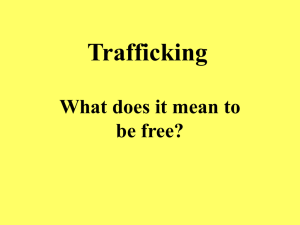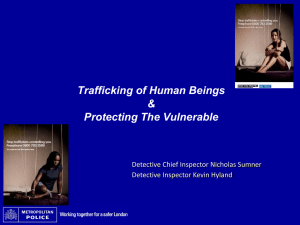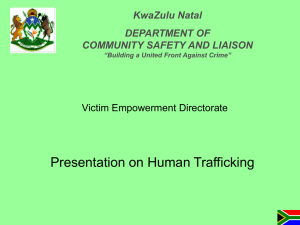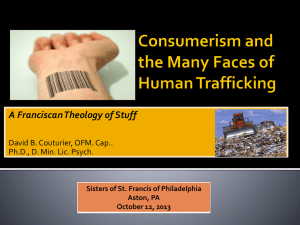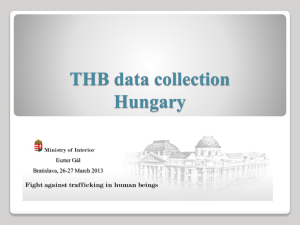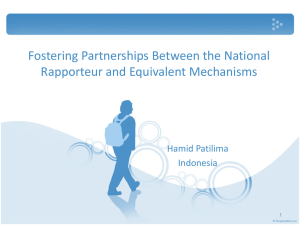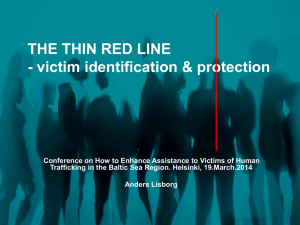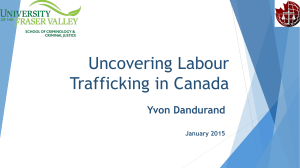Canada`s Temporary Foreign Worker Program & Human Trafficking
advertisement
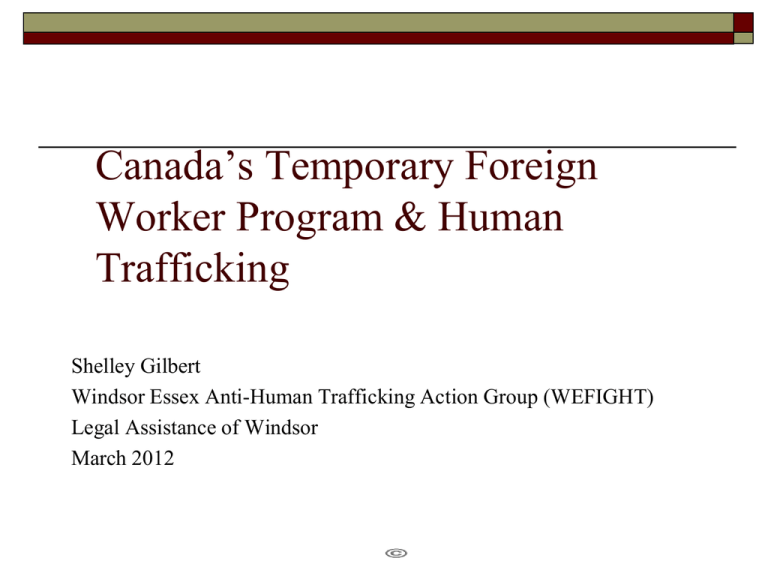
Canada’s Temporary Foreign Worker Program & Human Trafficking Shelley Gilbert Windsor Essex Anti-Human Trafficking Action Group (WEFIGHT) Legal Assistance of Windsor March 2012 Overview A Brief Overview of the Temporary Foreign Worker Program (TFWP) in Canada How we got here & why Key Aspects Policy Impact Human Trafficking in Windsor/Essex Definitions Elements of Trafficking Forced Labour as Trafficking Hawaii Case Common Elements of the TFWP & Human Trafficking Temporary Foreign Workers Definition All persons admitted on a temporary basis to Canada in order to work The TFWP Then and Now The Non-Immigrant Employment Authorization Program (1973) Assigned to specific employer Occupation, residence and length and terms of employment specified Change in conditions only permitted with written authorization from immigration officials Employment driven quotas Not a pathway to permanent residency The Non-Immigrant Employment Authorization Program (2012) Assigned to specific employer Occupation, residence and length and terms of employment specified Change in conditions only permitted with written authorization from immigration officials Employment driven quotas Not a pathway to permanent residency Expansion in numbers, countries and occupations Temporary Foreign Worker Program (2002) High Skilled Temporary Workers Pathway to permanent residency opened Ability to be accompanied by family members Not affected by proposed regulatory changes (4 years in Canada, 6 year ban) Pilot Project for Occupations Requiring Low Levels of Formal Training Seasonal Agricultural Worker Program SAWP No pathways to permanent residency Family ‘left behind’ Regulatory Changes Applicable April 2011 Policy Shifts When Conservatives took power, there was a rapid expansion of the Temporary Foreign Worker Program Between 2004 and 2008, temporary foreign worker admissions increased 71% In 2008, Canada admitted 192,519 temporary foreign workers vs. 149,072 permanent residents who entered Canada through the Economic Immigrant Class Statistics do not include TFW who had their work permits renewed inland, or those who remained on two year contracts. Some researches suggest that if these figures are included 300,000 vs 150,0000 Most Recently The federal government expanded the TFWP without simultaneously implementing monitors and controls to protect the foreign worker Position of the federal government has been that provinces hold legislative jurisdiction over employment matters Restrictions Labour mobility Physical mobility Limited healthcare Access to education Collective bargaining/Associations Inability to address exploitation/ abuse because employer has the power to terminate employment and deport Barriers to Full Participation Language barriers Geographic isolation Lack of community connections and social isolation Inability to access language or settlement services Lack of awareness and understanding of Canadian laws Recruitment Practices Add to Worker Vulnerability Recruitment fees Deception Monitoring within Canada Threats of deportation Statistics It is estimated that 12.3 million adults and children are forced into labour, bonded labour, and commercial sexual servitude at any given time”. (International Labor Organization, 2005) The total yearly profits generated by the human trafficking industry is $32 billion $15.5 billion of this is made in industrialized countries On average, $13,000 per year is generated by each “forced laborer.” This number can be as high as $67,200 per victim per year. Palermo Protocol Protocol to Prevent, Suppress and Punish Trafficking in Persons, especially Women and Children Trafficking in persons" shall mean the recruitment, transportation, transfer, harbouring or receipt of persons, by means of the threat or use of force or other forms of coercion, of abduction, of fraud, of deception, of the abuse of power or of a position of vulnerability or of the giving or receiving of payments or benefits to achieve the consent of a person having control over another person, for the purpose of exploitation. Ratified by Canada in 2002 Four Elements of Human Trafficking 1. Recruitment: Lured by false promises, deceived by working conditions, or enticed through newspaper, magazine or internet 2. Movement/Transportation: internationally: new, unfamiliar country 3. Coercion/Control: The use or threat of force, coercion, abduction, fraud, deception, abuse of power or payment to others in control of the victim 4. Exploitation: For the purpose of sexual exploitation…servitude, slavery or practices similar to slavery Forced Labour/Bonded Labour Recruitment Lured, deceived &/or kidnapped into coming to Canada with promises of work and a living wage. Pay large recruitment fees in order to get the job Movement May come with temporary work permit or deceived into making a false refugee claim and then moved about within the country. Control/Coercion Economic control is most often exerted Workers are forced to remain with employer due to TFW program requirement Documents may be taken Exploitation Sold to various employers by unscrupulous recruiters/agents and put at risk for imprisonment Not paid what was originally promised/not paid overtime Forced to continue using employers’ agents who continue to charge outrageous fees to workers for “keeping their jobs Supply & Demand Supply: Socio-cultural: Demand: Socio-cultural: Patriarchy Illiteracy Inadequate educational and employment opportunities Racial discrimination, racism and related intolerance Media and new technologies Economic: Economic disparities Feminization of poverty Globalization and its differential impact on women A lucrative business with high monetary returns Political: Feminisation of international migration Civil and military conflicts Growth of transnational crime Weak law enforcement mechanisms Corruption of police and law enforcers Male attitudes and perceptions of women in society Consumerist behaviour with the commercialization and commodification of women’s bodies Economic: Demand by employers for an unskilled and cheap labour market Confinement of women's labour in the domestic and entertainment spheres and in the informal sector Development policies and patterns that depend on temporary migrant workers Political: Unequal and exploitative political and economic relations Restrictive migration policies Sales of arms and increased armed conflicts Weak law enforcement mechanisms (JPIC Working Group on Trafficking in Women and Children, 2003) The Hawaii Case In the old days, they used to keep slaves in their place with whips and chains," Simon said in an interview. "Today, it is done with economic threats and intimidation." FBI Agent Tom Simon: Honolulu Star; Sept. 3, 2010 Common Elements of the Temporary Foreign Worker Policy and Human Trafficking Elements of the TFWP Elements/Indicator of Human Trafficking Attractive to individuals who are living in poverty Women, youth, visible minorities, individuals with limited education Vulnerable individuals who are living in poverty Women, youth, visible minorities, individuals with limited education Individual MUST remain with specific employer for work permit to remain valid or face deportation • Often live in housing supplied by the employer or his/her agent Coercion/Control “use or threat of force, of coercion, of abduction, of fraud, of deception, of the abuse of power or of vulnerability” Is not free to leave or come and go as he/she wishes Can not bring their families to Canada Identification of abusive employers responsibility of the worker Not allowed to speak with/have contact with family Survivors must self-identify to CIC Windsor Essex Anti-Human Trafficking Action Group The action group provides direct services to persons who are found to be trafficked and develops effective community strategies in collaboration with organizations who may provide assistance. In addition, the group provides education and awareness building to the general public and to service providers in the Windsor and Essex county area about the presence of trafficked persons in Canada and within our area. Committee Organizations: Legal Assistance of Windsor Victim Services of Windsor Essex Children’s Aid Society New Canadian Centre of Excellence University of Windsor, School of Social Work Bi-lingual Legal Clinic Teen HealthCentre/Street Health New Canadian Centre/YMCA Women’s Enterprise Skills Training of Windsor Diocese of London Ministry to Refugee Claimants City of Windsor, Social Services Victim Witness/Windsor Essex
